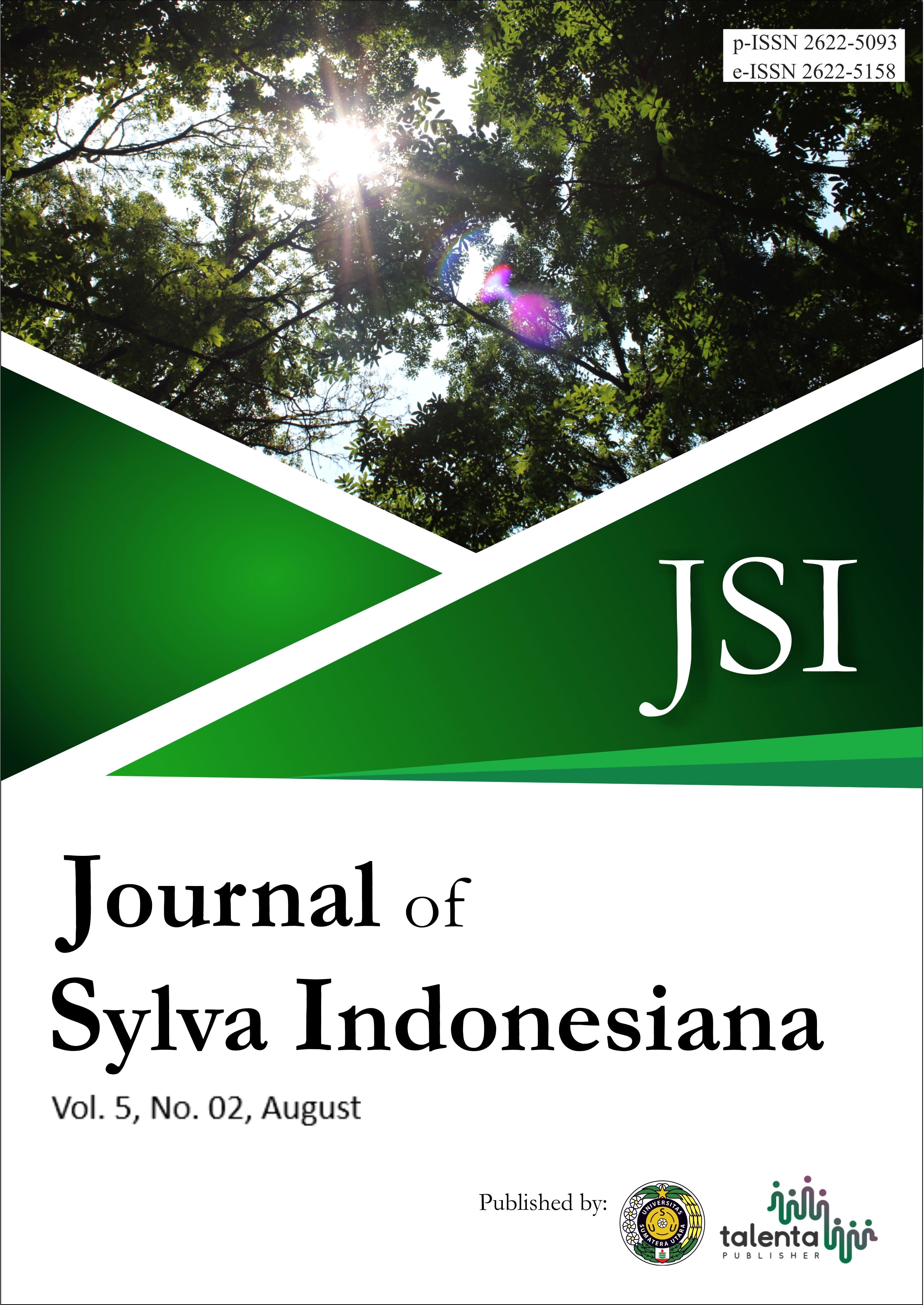Empowerment of Abandoned Ponds for Sustainable Mangrove Rehabilitation Activities in Percut Sei Tuan, Deli Serdang, Indonesia
DOI:
https://doi.org/10.32734/jsi.v5i02.8727Keywords:
Diversity Index, Flooding, Mangrove Ecosystems, Ponds, RehabilitationAbstract
Mangrove ecosystems provide important functions for ecosystem service. However, the degradation of mangrove forests, especially conversion to aquaculture ponds is a driver for deforestation. Therefore, this study aimed to analyze the mangrove vegetation and duration of inundation in ponds before and after rehabilitation activities were conducted on abandoned ponds. In this analysis, we used the census method to collect structural data, the Important Value Index (IVI), composition and structure, and the diversity index. To determine the duration of inundation at the observation sites in a pond in Tanjung Rejo, Percut Sei Tuan village, we deployed one water logger and two Mini Buoys at ponds. At the observation site, eight pure mangrove species have been founded, namely Avicennia alba, A. marina, Bruguiera gymnorrhiza, Excoecaria agallocha, Rhizophora apiculata, R. mucronata, R. stylosa, and Nypa fruticans. The main species was A. marina which is a total of 756 idv/ha at the seedling stage 52.81 idv/ha at the sapling stage, and 268.09 idv/ha at the tree level. The highest IVI has founded in seedlings, saplings, and trees at A. marina, which was 99.30%. 80.41% and 94.49%, respectively. Rehabilitated Avicennia spp that grew only 2.4% from 2000 seedlings. The low growth of seedlings was influenced by the pond condition which was always in a state of flooding. The current study provides important information that in carrying out planting or rehabilitation activities it is necessary to determine which inundation rotation should be a priority considered.
Downloads
References
Alongi DM. Mangrove forests In Blue Carbon, Springer Cham, pp. 23-36, 2018.
Wang L, Jia M, Yin D, Tian J. “A review of remote sensing for mangrove forests: 1956–2018,†Remote Sensing of Environment, vol. 231, p 111223, 2019.
Hamilton SE, Lovette J. “Ecuador’s mangrove forest carbon stocks: A spatiotemporal analysis of living carbon holdings and their depletion since the advent of commercial aquaculture,†PloS one, vol. 10, no. 3, p e0118880, 2015.
Xiong Y, Jiang Z, Xin K, Liao B, Chen Y, Li M, Zhang C. “Factors influencing mangrove forest recruitment in rehabilitated aquaculture ponds.†Ecological Engineering, vol. 168, 2021.
Basyuni M, Sulistiyono N. “Deforestation and reforestation analysis from land-use changes in North Sumatran Mangroves, 1990-2015,†IOP Conference Series: Materials Science and Engineering, vol. 309, p 012018, 2018.
Duncan C, Primavera JH, Pettorelli N, Thompson JR, Loma RJA, Koldewey HJ. “Rehabilitating mangrove ecosystem services: A case study on the relative benefits of abandoned pond reversion from Panay Island Philippines.†Marine pollution bulletin vol. 109, no. 2, pp. 772-782, 2016.
Herbeck LS, Krumme U, Andersen TJ, Jennerjahn TC. “Decadal trends in mangrove and pond aquaculture cover on Hainan (China) since 1966: mangrove loss fragmentation and associated biogeochemical changes.†Estuarine Coastal and Shelf Science, vol. 233, p 106531, 2020.
Balke T, Vovides A, Schwarz C, Chmura GL, Basyuni M. “Monitoring tidal hydrology in coastal wetlands with the Mini Buoy: applications for mangrove restoration.†Hydrology and Earth System Sciences 25: 1229–1244. 2021.
Kauffman JB and Donato DC. Protocols for the measurement, monitoring and reporting of structure, biomass and carbon stocks in mangrove forests, Working Paper 86. CIFOR, Bogor, 2012.
Harefa MS, Nasution Z, Mulya MB, Maksum A. “Mangrove species diversity and carbon stock in silvofishery ponds in Deli Serdang District North Sumatra Indonesia,†Biodiversitas Journal of Biological Diversity, vol. 22, no. 2, 2022.
Capetillo-Piñar N, Espinosa Sáez J, Tripp Valdez A, Tripp Quezada A. “The impact of cyclonic activity during 1981-1985 and 2004-2009 on taxonomic diversity of mollusks in the Gulf of Batabanó Cuba,†Hidrobiológica vol. 26, no. 1, pp. 121-131. 2016.
Clarke KR, Warwick RM. “A Taxonomic distinctness index and its statistical propertis.†Journal of Applied Ecology vol. 35, pp. 523-531. 1998.
Kitamura, S., C. Anwar, A. Chaniago, S. Baba. “Mangrove guide book in Indonesia (Bali and Lombok). Japan International Cooperation Agency (JICA).†The Internasional Society For Mangrove Ecosystem (ISME), 2003.
Noor YR, Khazali INN, Suryadiputra. Guide to Introduction to Mangroves in Indonesia Layoffs/WI-IP, Bogor, 2006.
Hasibuan IM, Amelia R, Bimantara Y, Susetya IE, Susilowati A, Basyuni M. “Vegetation and macrozoobenthos diversity in the Percut Sei Tuan mangrove forest North Sumatra Indonesia,†Biodiversitas Journal of Biological Diversity vol. 22, no. 12, pp. 5600-5608. 2021.
Yanti G, Jamarun N, Suyitman S, Satria B, Sari RWW. “Mineral status of soil sea water and mangrove (Avicennia marina) forages in several coastal areas of West Sumatra.†Veterinary World, vol. 14, no. 6, p 1594, 2021.
Rafiq M, Mukhtar E. “The Vegetation of Mangrove Forest in Mandeh Bay West Sumatera-Indonesia.†The International Journal of Social Sciences World (TIJOSSW), vol. 2, no. 01, pp. 95-102, 2020.
Qasim M, Abideen ZA, dnan MY, Ansari R, Gul B, Khan MA. “Traditional ethnobotanical uses of medicinal plants from coastal areas.†J coast life Med, vol. 2, no. 1, pp. 22-30, 2014.
Basyuni, M., Slamet, B., Sulistiyono, N., Munir, E., Vovides, A., Bunting, P. “Physicochemical characteristics, nutrients, and fish production in different types of mangrove forests in North Sumatra and the Aceh Provinces of Indonesia.†Kuwait Journal of Science, vol. 48, no. 3, 2021.
Suwardi, Elis T, Ambeng, Dody P. Keanekaragaman Jenis Mangrove Di Pulau Panikiang Kabupaten Barru Sulawesi Selatan, Jurusan Biologi Fakultas Matematika dan Ilmu Pengetahuan Alam, Universitas Hasanuddin, Makassar, 2013.
Van Loon AF, Dijksma R, Van Mensvoort MEF. “Hydrological classification in mangrove areas: A case study in Can Gio, Vietnam.†Aquatic Botany, vol. 87, no. 1, pp. 80-82. 2007.
Chambers LG, Davis SE, Troxler T, Boyer JN, Downey-Wall A, Scinto LJ. “Biogeochemical effects of simulated sea stage rise on carbon loss in an Everglades mangrove peat soil.†Hydrobiologia vol. 726, no. 1, pp. 195-211, 2014.
Chambers LG, Guevara R, Boyer JN, Troxler TG, Davis SE, “Effects of salinity and inundation on microbial community structure and function in a mangrove peat soil.†Wetlands vol. 36, no. 2, pp. 361-371, 2016.
Downloads
Published
How to Cite
Issue
Section
License

This work is licensed under a Creative Commons Attribution-NonCommercial 4.0 International License.



















